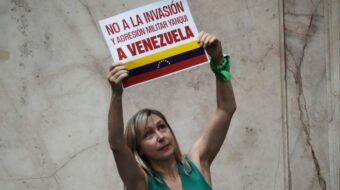“Hegel remarks somewhere that history tends to repeat itself. He forgot to add: the first time as tragedy, the second time as farce”
Karl Marx, The 18th Brumaire of Louis Bonapart
On April 9, 1948 in Bogota, Colombia, an assassin’s bullets killed the eloquent, populist Liberal Party leader Jorge Eliécer Gaitán. Onlookers murdered shooter Juan Roa Sierra, variously described as deranged or a fascist. Radio broadcasters quickly blamed the assassination on the government and its Conservative Party leaders. For months, police and paramilitaries had been eliminating adherents of a newly unified Liberal Party widely expected to propel Gaitán into the presidency in the 1950 elections.
The assassination was tragedy, and so too was violent upheaval that within 48 hours took 330 lives in Bogota and killed 3000 people throughout Colombia over two weeks. Then ten years of conflict between guerrillas identifying with Gaitán’s Liberal Party wing and military forces of governments led by the Conservative Party or by dictator Rojas Pinilla caused over 200,000 deaths. Beginning with the early 1960’s, war between leftist insurgents and the government’s U.S. supported military machine killed tens of thousands more.
Congressman Gaitán, condemning the 1928 massacre of United Fruit Company banana workers, castigated a “government [with] its tremulous knee on the ground before Yankee gold.” The young lawyer founded the short-lived National Revolutionary Left Union as a vehicle for land reform. Rejoining the Liberal Party, Gaitán served as Bogota mayor in 1936 and later as national education minister and labor minister. The branch of the Liberal Party headed by Gaitán called for agrarian reform, poverty alleviation, and poor people’s rights. Party disunity led to Conservative Party victory in the 1946 presidential elections.
On February 7, 1948 in Bogota, a “silent march” ended with Gaitán’s famous “Oration for Peace.” Mr. President,” he said, “We ask you for deeds of peace and civilization…We deeply love this nation, and we don’t like that our victorious ship has to navigate rivers of blood.”
Colombians intent upon preserving Gaitán’s memory have long regarded April 9 as a day for public observances. Gaitán may no longer be the primary focus of that day. The 2011 Law of Victims and Restitution of Lands redefined April 9 as a catch-all “Day of Memory and Solidarity with Victims.”
In 1948, the government quickly, and erroneously, attributed violence and Gaitan’s killing to communists wanting to eliminate a rival and bring down the state. Colombia cut relations with the Soviet Union. John C. Wiley, U.S. Ambassador to Colombia in 1946-1947 had reported that Gaitán “blindly promoted state socialism” and “would deplume our eagle.”
Simultaneously, amidst shootings, fires, and tumult, the ninth Pan American Conference was meeting in Bogota. For safety, delegates retreated to a secure warehouse. U. S. Secretary of State George C. Marshall was on hand to promote establishment of the Organization of American States and thereby create an institutional framework for cold war in Latin America. Marshall explained to reporters that chaos enveloping the city and nation represented “the first important communist attempt in the Western hemisphere since the end of the war.” He reiterated that theme in radio broadcasts to Colombians.
U.S. Ambassador Beaulac had warned Gaitán earlier of supposed communist plans for an uprising that would be blamed on his Liberal Party. An Embassy official supposedly offered Gaitán a prestigious European academic position in return for leaving Colombian politics.
History did repeat. The Organization of American States (OAS) returned to Colombia on April 14-15 as the 6th Summit of the Americas, which it sponsored. News coverage centered on Cuba’s exclusion from the meeting situated in Cartagena. Evidently Ecuadorian President Rafael Correa regarded Cuban absence, a non-event, as farce. His government stayed away.
The OAS, having expelled Cuba in 1962, worked afterwards to isolate and enforce continent-wide hostility against revolutionary Cuba. Under Latin American pressure, the United States relented in 2009 allowing the OAS to readmit Cuba, which remains a non member.
The “Bogotazo,” as the leaderless rebellion following Gaitán’s killing is labeled, manifested another Cuba connection. Young Fidel Castro was in Bogota at the time representing the (Cuban) University Student Federation at an international student conference. He consulted with Gaitán.
And CIA operative John Mepples Espirito was in Bogota in 1948 monitoring leftist students. Later in Cuba he fought against Batista and was jailed for complicity in the death of a comrade. Mepples’ revelations to Cuban intelligence officials about helping to assassinate Gaitán for the CIA became the basis for a documentary film shown to Gaitán’s daughter Gloria in 1961. Verification problems prevented its release. Later jailed as a counterrevolutionary insurgent, Mepples in 1980 told more in return for release from prison. He claimed he and others had set up Juan Roa Sierra as the assassination’s “fall guy.”
U.S. lawyer Paul Wolf eventually gave up on Freedom of Information requests to secure U.S. intelligence material on the assassination. The CIA refused to release relevant microfilms, and, according to Wolf, the FBI had disposed of hundreds of files.
Prior to the Summit of the Americas, host President Juan Manuel Santos announced he’d urge the U.S. government to let up on Cuba. That too may end as farce.










